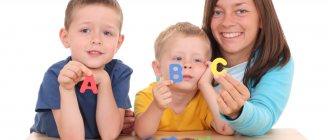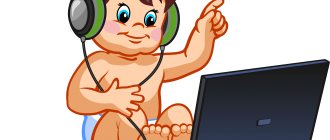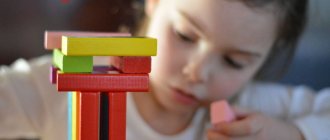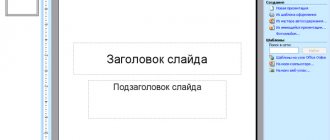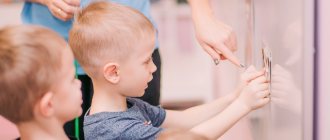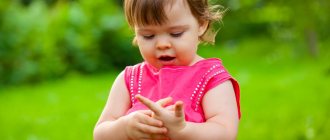Maria Montessori believed that a child's intelligence and knowledge of the world always originate in the senses. Any thought is always preceded by a process of collecting information. This means that the more subtly all the analyzers work, the more chances a person has to solve the problem facing him.
In his book “The Absorbent Mind of the Child,” M. Montessori says that sensory development allows you to open up a whole new world for the baby, making more things and their properties visible, as if someone suddenly turned on the light in a dark room.
It is important to understand that what adults consider obvious, a child has yet to learn: a small stone is lighter than a large stone, but at the same time heavier than a feather, glass is smooth and cold to the touch, and an autumn leaf is warm and rough. A child's absorbent mind is wired for learning, but it is important to place the child in the right environment where he can put his natural curiosity to use.
For more information about Maria Montessori's approach, watch our webinar for parents:
History of Sensory Education in Montessori
Maria Montessori was not the first teacher to draw attention to the importance of developing children's senses. When developing her approach, she relied heavily on the work of the French physician and teacher Edouard Seguin, who at one time worked with children with special needs and created his own system of exercises for developing children’s perceptions and teaching them everyday skills. Jean-Jacques Rousseau and Johann Heinrich Pestalozzi in their works also paid attention to the role of the development of sensory organs in children's learning.
Robert Baden-Powell, founder of the Scout movement and contemporary of Maria Montessori, said that to gain knowledge about the world, children need real experience of interacting with objects. This statement formed the basis of his theory of active learning. He highly valued Maria Montessori's pedagogical approach, noting that if teachers stop commanding and begin to more delicately reinforce a young child's natural need for new experiences, teachers can create a much more solid basis for subsequent learning and development. In his opinion, the idea of education as hard and exhausting work is hopelessly outdated.
Maria Montessori herself began her career working with special needs children who were deprived of adequate sensory stimulation: they had almost no toys, and their whole life was reduced to a series of basic caregiving activities. She was able to clearly prove that changing the living conditions of children significantly changes the level of their abilities. Today, the influence of the environment on a child’s development has been proven at the neurophysiological level. We recommend reading John Medin's book, Rules for Your Child's Brain Development, to become more familiar with this topic.
Maria Montessori created a system of sensory education based on many years of experience observing children and studying the works of outstanding teachers and doctors. Although she was not the first to discover the need for sensory experiences in child development, she was certainly the first educator who was able to draw public attention to this fact.
Methods for studying sensory standards
At the ascertaining stage, we tried to adhere to the recommendations described in the works of L.A. Wenger. and Strebeleva E.A.
L.A. method Wenger's grouping of toys
The proposed task allows us to determine the degree of development of shape perception, the ability to use geometric standards as samples to determine the main shape of the examiner of objects, that is, to group objects according to their shape.
The following materials are used: boxes without lids 20 by 20. They must have the same color. In this case, a 4 by 4 image with a reference sample should be used.
On the front wall of one of the boxes there is a square, on the second - a triangle, on the third - a circle.
You need to place 8 square, 8 triangular and 8 round objects in the bag.
The examination is carried out according to the following scheme: the child must arrange boxes on the table. You need to draw the preschooler’s attention to this example: here is such and such a figure, and here is such and such. Then you need to take some objects out of the bags and ask: what does this object look like?
When the child can point to the correct standard, we ask him to:
- Throw it in the box
Then another object is demonstrated using the same scheme.
Then we give the child the opportunity to arrange the toys on his own and ask him: “Now please carefully examine and arrange all the toys, each in its own box.”
Training: if the child is not able to complete this task himself, you need to offer him toys sequentially and ask him to put them in the right boxes. If a child puts down a toy without focusing on a sample, then you need to draw his attention to this sample so that he can relate the toy to it.
The child’s actions are assessed according to the following algorithm:
- the preschooler understands and completes tasks;
- what are the features of completing the task, the preschooler acts in accordance with the model;
- Is the child’s work purposeful?
- how trainable it is;
- how the child feels about the result.
Result
1 point – the child acts inappropriately, which leads him to misunderstanding and inability to accept the task.
2 points – the child, even after being trained, cannot take into account the main principle of the task and is not able to focus on the standard model.
3 points - the child puts down the toys after he has been trained; match their shape with the model.
4 points – the child is interested in the final result, tries to take into account the sample.
Strebeleva’s “Matryoshka” technique
The following exercise was developed by Strebeleva E.A. It involves disassembling and assembling a matryoshka doll consisting of four parts.
By completing this task, the child demonstrates his ability to focus on magnitude.
Only the matryoshka acts as equipment.
The examination is carried out according to the following scheme: first, the child is shown a matryoshka doll. He must see what is in it. Then you need to ask him to put the nesting doll back together. If it is difficult for him to do this on his own, he needs to be trained.
The training proceeds like this: after the child has been shown how to make nesting dolls from two to four parts, you need to ask him to complete the task independently.
Then you need to appreciate the child’s actions: how much he understands and accepts the task, how he completes it, how trainable he is and how he feels about the result obtained.
1 point – the child, even after good training, cannot adequately complete the task.
2 points - the child understands the task and tries to act with the nesting doll, but is not able to determine the size of its parts, so his actions look chaotic.
It is necessary to monitor the adequacy of actions during the learning process. But after training, the child has no independence, he is not interested in the result of his activities.
3 points – the child understands and completes the task, selecting elements, tries to complete the task independently and is interested in the result obtained.
4 points - the child understands and completes the task well, folds the matryoshka doll, uses trying on, and shows interest in the final result.
Strebeleva’s technique “Cut pictures”
The following technique is based on the works of Strebeleva E.A. You need to put together cut pictures from three parts.
This task allows us to identify children’s ability to perceive the integrity of the object that is drawn in the image. With this exercise you can determine the level of holistic perception of the image of an object.
Equipment for an item: two pictures depicting the same item are selected. One of them is cut into three parts.
The examination is carried out according to the following scheme: the child receives three parts of the picture and must connect them.
If the child cannot correctly complete the task on his own, the teacher shows the child the whole picture and again asks him to complete the task. If there is no result, then the parts are superimposed on the whole. Then the baby must repeat it himself.
The following factors are assessed:
- whether the child accepts the task;
- in what ways he tries to fulfill it;
- how trainable it is;
- how he feels about the result;
- what result.
1 point – the child is inadequate in completing the task even after receiving training. He does not understand and does not accept the task.
2 points - he accepts the task, but cannot understand it. He superimposes one part on another, during training he acts adequately, but something prevents him from moving on to independent actions. He also shows indifference to the result.
3 points – the child can accept and understand the task, tries to connect all the parts into a whole image, but cannot complete it independently; After training, he is able to complete the task correctly and is interested in the final result.
4 points - the child understands and accepts the task, completes it himself, uses the trial method and trying on.
Unfolding and folding pyramids
When performing this task, you need to focus on the magnitude, what correlating actions are available, which hand is dominant, how coordinated both hands are, how purposeful the child’s actions are.
Training: if the child cannot assemble the pyramid himself, you need to give him one piece at a time and point to the rod with a gesture so that the child understands where the ring needs to be placed. After this, you need to encourage the child to complete this task himself.
It is assessed whether the task is accepted, whether the child takes into account the size of the rings, how trainable he is and how he feels about performing the exercise and the final result.
1 point – inadequacy in the child’s performance. Even after training has been received, the child tries to put rings on the rod, while the rod is closed with a cap.
2 points – the child accepts the task and tries to assemble a pyramid. But he does not adhere to the order of the rings in size, so the pyramid, although assembled, is not beautiful. Both hands act uncoordinated, it is difficult to understand which one is leading. The child is not interested in what the result of the work will be.
3 points – the child immediately accepts the task and tries to put the rings on the pyramid, without taking into account their size. After training has been carried out, he performs the task correctly. You can immediately see what kind of hand he has and how uncoordinated the actions of his hands are. He evaluates his results adequately.
4 points – in this case the child acts independently. The baby tries to take into account the size of the rings himself. It is clear that he has a leading hand. Both hands act in concert. The child is interested in the end result.
Exercise to find paired illustrations
This task helps determine at what level the child’s visual perception of pictures depicting objects is, and how much he understands gesture instructions.
Equipment: four pairs of images with objects are selected.
The examination is carried out according to the following principles: two images with objects are laid out in front of the child. The teacher holds such a pair in his hands. Using a gesture, he shows the preschooler that he has two similar pictures, just like the child’s. Then he closes these pictures, takes out one of them and asks to show a similar one.
Training: if the child does not complete the task, he is shown how paired pictures relate.
The child’s actions are assessed according to the following criteria: how much he understands and accepts the task, whether he makes choices, whether he understands instructions using gestures, how teachable he is, how he feels about his activities.
1 point - the child acts according to the following scheme: he turns the illustrations over, tries not to fix his gaze on the image, tries to take the picture from the adult. All this speaks to the inadequacy of the baby.
2 points - in this case, he understands the task, during training it is clear that he can distinguish between paired images, but he is not interested in assessing his own performance, and cannot complete the task on his own.
3 points - before learning, the child may make a mistake, but it is clear that the task was understood correctly. After training, he acts confidently and after completion sees that he was able to achieve the desired result.
4 points – the child understands his task, is immediately able to find paired pictures, is interested in completing the task and in the result obtained.
Exercise on playing with multi-colored cubes according to the method of Stebeleva E.A.
Using this task, you can determine how much your child is able to identify colors and name them.
The equipment used is cubes of blue, yellow, green and red colors.
The examination is carried out according to the following scheme: the child must show the necessary cubes, relying on the same color as the adult’s in his hand. To do this, you need to place two or four cubes in front of the child. Then the teacher asks to show which cube has a given color or asks to name the color of a certain cube.
Actions are assessed according to the following criteria: whether the child understands and accepts the task, whether he can compare colors, whether he can recognize a color by name, whether he can name the colors himself, whether he accompanies the result with speech, and how he feels about performing the exercise.
1 point - the baby has no understanding of what color is, he cannot distinguish between different colors.
2 points - the child cannot identify colors by name even after training, does not strive to get results, and does not show interest in the activity.
3 points - in this case, he is interested in the result of the task, compares the colors and identifies them by word.
4 points – the child is able to distinguish different colors, gives them names, identifies them by name, and is interested in the final result.
Conducting research, we determine the following levels of sensory development:
- the highest level is shown by children who independently complete the task and score from 24 to 18 points;
- the average level is shown by children scoring from 12 to 18 points;
- sufficient level – from 6 to 12 points;
- initial level – less than 6 points.
The results of the study are presented in the table.
Rules for organizing sensory education according to Montessori
Maria Montessori noticed that at a certain age, children's behavior and motivation are very similar. For example, in the first three years a child is especially sensitive to order. This childish “pedantry” is necessary for the child to create a stable image of this world. It can also be used to develop a child’s natural need for knowledge by creating tasks that are exciting for a certain age, which would help the child master the most important qualities of objects: color, size, shape, material.
As Maria Montessori herself admitted, the work of creating the sets was not easy: it was necessary to create material that would demonstrate properties in isolation, have pedagogical value, and at the same time be attractive to the child. This is how a set of Montessori sensory material appeared.
The main objectives of Montessori sensory exercises
- Teach the baby to perceive, compare and classify sensory experiences of different modalities,
- Expand the child’s sensory experience, teach him to notice even small differences, develop the child’s senses as much as possible,
- Teach your child to use his own memory: “I remember what yellow is, and I can always imagine it in my head,”
- Teach to critically evaluate any information and develop the habit of striving for maximum accuracy when gaining knowledge about the world,
- Create a basis for the emergence of abstract thinking and imagination.
Let us explain with an example how sensory and abstract thinking are connected:
Let's say you've never seen an okapi. Now your task is to imagine this animal by description: it is a bay horse with the legs of a zebra and the head of a giraffe. Happened? If so, congratulations, your sensory development is on point, because for this exercise you need to have an understanding of the colors of horses, the coloring of a zebra and the body structure of a giraffe.
Any abstract idea is essentially a clever interweaving of various information from our real experience. That is why a child’s intelligence begins in early childhood and the ability to exercise all the senses over and over again.
What can you find in the sensory development area of the Montessori center?
Visual information
- Shapes: sets of geometric shapes, as well as more complex shapes (for example, animal figures or plant leaves)
- Volumetric figures: Pink Tower, Brown staircase, Red barbells, Montessori weight cylinders
- Colors: sets of basic colors, card index of shades
Tactile information
- Texture: palpable board, rough tablets, baskets with rags
- Temperature: heat jugs, heat plates
- Weight: weighing cylinders and plates
Stereognostics
- Sorting small items, magic bag
Audio information
- Volume: sound boxes, musical accompaniment of classes
- Height: bells, sound cylinders, musical instruments
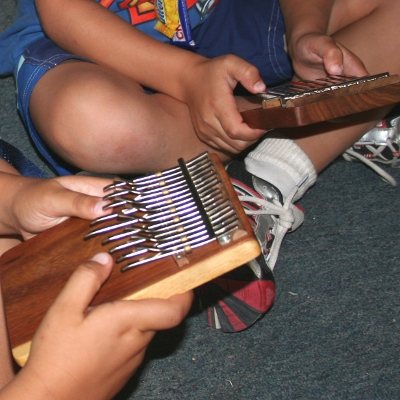
Taste and smell
- Taste bottles, conversations during meals
- Jars with scents
In addition to exercises with isolated sensory qualities, in a Montessori space you can always find sets that combine several qualities, such as color and shape:
- Binomial cube
- Trinomial cube
- Constructive triangles
- Montessori squares
- Cylinders without handle
The study of sciences according to M. Montessori also begins with sensory education. Acquaintance with the basic qualities of objects of the natural and cultural world prepares the child for studying social sciences, biology, physics, chemistry and even mathematics:
- Sets of leaves of different plants
- Thematic puzzles
- Maps and globe
- Flags
- Sets with natural materials
- Reproductions of artists and nature photographs
Magnitude
Tasks:
- show objects of contrasting size upon request;
- arrange objects in ascending and descending order;
- name the corresponding quantity ratios.
Age indicators:
4 years: long - short, wide - narrow, high - low.
5 years: 4 gradations of each characteristic, determined by comparison (the red stripe is shorter than the yellow one, but wider than the green one).
6 years: 5 gradations of each characteristic, determined by comparison.
Conclusions:
— ideas about size are formed according to age;
- there are no concepts of size:
- does not differentiate objects of contrasting size;
- does not arrange objects in ascending and descending order;
- does not use words in speech that characterize quantities and their relationships.
Montessori Sensory Development Ideas at Home
Despite the fact that Montessori centers use specialized kits for the development of children, it is not difficult to create a game that enriches a child’s sensory experience.
- Animal competitions. Discuss with your child how different animals move and try to organize a competition: draw a start and finish line and ask them to run sideways like a crab, hobble like a bear, or jump like a hare.
- Modeling. Kinetic sand, salt dough, plasticine and clay perfectly develop a child's tactile sensitivity. You don’t have to try to create a masterpiece right away: just learn how to roll balls, flatten them into pancakes, stretch them into sausages, squeeze them and watch how the material seeps through your fingers
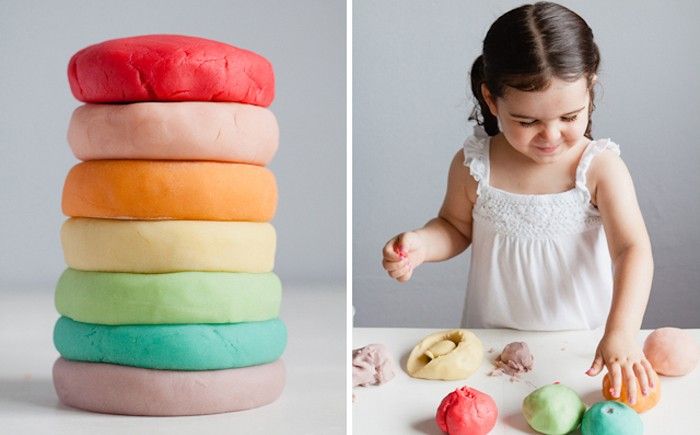
- Draw with crayons on the pavement and play hopscotch. Like the previous exercise, this trains not only the senses, but also the child’s coordination.
- Game of silence. Is it just not interesting to remain silent anymore? Invite your child to remember 5 different sounds that he heard during a minute of silence (car horn, bird sounds, people talking, a dropped pencil, etc.)
- Treasure hunt. Draw a list of objects that your child should find during your next walk (a long rough pine cone, a red leaf, a yellow leaf, a dry branch, etc.). Don't forget to take a pen with you to cross out what you find.
- Drawing with stamps, fingers, brushes and even cotton swabs. It is difficult to overestimate the impact of free creative activities on a child’s development.
- Guess the smell. Place items with different scents in opaque boxes: your favorite shampoo, orange peel, a little vanilla, dried cloves, fried cutlet. Organize a competition for the keenest sense of smell.
- Experiment with musical instruments: xylophone, glucophone, kalimba, drum, tambourine, shaker, pipe. It is not necessary to immediately enroll in a music school to introduce your child to music.
- Guess the product by taste. Blindfold your child and ask him to guess what's for lunch today.
- Let your child walk barefoot more often, because there is a whole world under his feet: sand, lawn, stream, pebbles.
Time orientation
Tasks:
- show the corresponding time categories in the pictures;
- name the time categories shown in the pictures;
- select a series of pictures to the corresponding time categories and explain the selection criteria.
Age indicators:
4 years : morning, afternoon, evening, night.
5 years : morning, day, evening, night, yesterday, today, tomorrow, seasons.
6 years: morning, afternoon, evening, night, day, earlier, later, yesterday, today, tomorrow, seasons.
Conclusions:
— ideas about time are formed according to age;
— temporary representations are not formed:
— does not find it in the pictures;
- does not name;
- doesn’t explain.
conclusions
The development of a child begins with the development of his senses. In the 21st century, this is not just the opinion of teachers, but a scientifically proven fact. At an early age, it is very important for a child to learn as much as possible about the world around him using all his senses, which is why no computer can replace a child’s real experience of being in a different environment (forest, park, store, kitchen, etc.). Try to introduce your baby to a variety of objects, and think about how to organize a sensory development area for him, if the ideas of Maria Montessori are close to you.
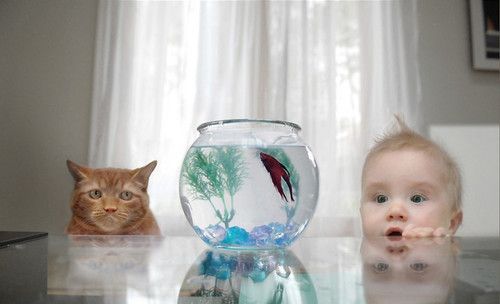
Results of the study at the ascertaining stage of the experiment
| Total in group | high level | average level | low level | ||||
| quantity | % | quantity | % | quantity | % | ||
| Experimental group | 24 | 5 | 20,8 | 6 | 25 | 13 | 54,2 |
| Control group | 29 | 4 | 13,8 | 11 | 37,9 | 14 | 48,3 |
As the results of the study show, a high level of sensory ideas about color was identified in 4 preschool children in the control group - 13.8% and in 5 preschool children in the experimental group - 20.8%.
The average level of sensory ideas about color was revealed in 11 preschool children in the control group - 37.9% and 6 preschool children in the experimental group - 25%.
A low level of sensory ideas about color was identified in 14 preschool children in the control group - 48.3% and 13 preschool children in the experimental group - 54.2%.
As we can see, the results showed that most children have a low level of formation of sensory ideas about color.
Related posts:
- Experimental study of the development of coherent speech in preschool children with ODD. Diagnosis of coherent speech in children is carried out using accessible...
- From experience in diagnosing and forming creative imagination Research on creative imagination - diagnosis and its formation in children...
- What is "War and Peace" about? Summary of the novel “War and Peace” by chapters. All answers...
- Features of the formation of sensory standards in young children Formation of sensory standards in preschool children. The tasks of forming sensory…
Orientation in space
Tasks:
— show relevant spatial references;
- move in a given direction;
- name the corresponding spatial landmarks.
Age indicators:
4 years: show objects located above, below, in front, behind, left, right.
5 years: show objects located above, below, in front, behind, left, right, in front of me, to my right, to my left.
6 years old: show objects located above, below, in front, behind, left, right, left, between, next to, around.
Conclusions:
— spatial representations correspond to age;
- there are no concepts of space;
- does not perform a movement in the indicated direction according to verbal instructions;
- does not determine position in space in relation to itself;
- does not use words denoting the location of an object in space.
